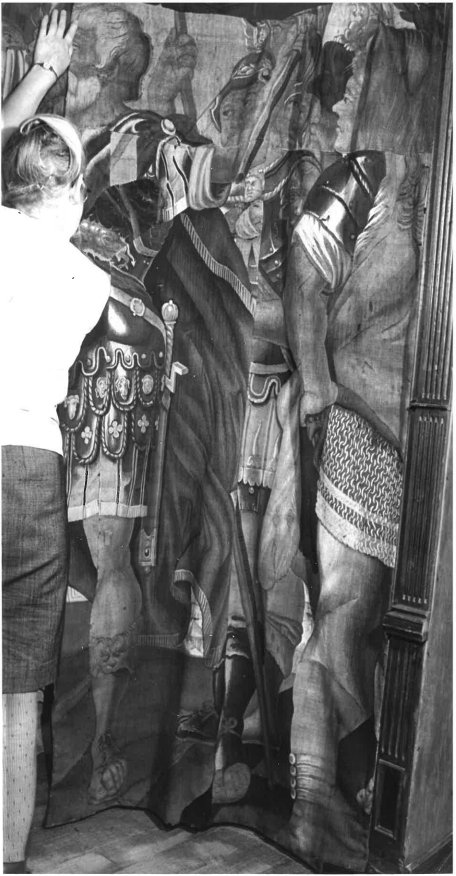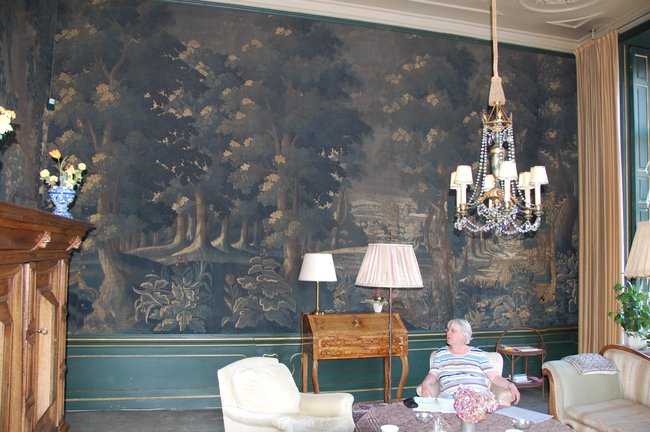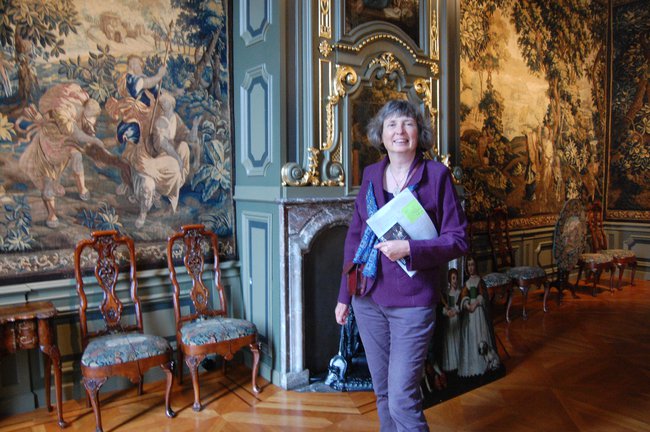Motivation and history of the project
Tapestries and other tapestry-woven objects are seldom visible in the Netherlands, for various reasons. These are old textiles that, for the sake of preservation, cannot be hung without limit or be exposed to much light. That is why so many tapestries are stored rolled up and out of sight in museum depots. And as the saying goes: out of sight, out of mind.
The aim of the Corpus of Tapestries in the Netherlands is therefore to shine the (proverbial) light on and share knowledge about tapestries in the Netherlands.
The basis of the Corpus of Tapestries in the Netherlands is the inventory carried out by Drs. E.J. (Elisabeth) Kalf (1901-1994) from the late 1950s until her death. Initially, she was commissioned by the Stichting Werkplaats tot herstel van Antieke Textiel in Haarlem (HAT) to research the material condition of the Dutch collection of tapestries. However, the priority soon became tracing and describing the tapestries. The objectives were to inventorise tapestries as part of the inventory of the Dutch national art collection – something that had not been done before -, to contribute to the knowledge about the art of tapestry in general and to stimulate the love and care for old tapestries.
In 1988, Elisabeth Kalf published the first volume of the Corpus of Tapestries in the Netherlands, Waar legwerk hangt, which covers the tapestries in the provinces of Zeeland, Noord-Brabant and Limburg. This book contains a total number of 39 catalogued works, of which 25 are publicly owned tapestries, the remainder privately held or in circulation in the art trade. The present publication therefore does not deal any further with the tapestries in those three southern provinces, and only briefly mentions some recent acquisitions made in those regions.
A separate catalogue was dedicated to the extensive collection of tapestries and other tapestry-woven objects held by the Rijksmuseum in Amsterdam. This book, European Tapestries in the Rijksmuseum, written by Ebeltje Hartkamp-Jonxis and Hillie Smit, was published in 2004 as volume two of the Corpus of Tapestries in the Netherlands. Here, too, the objective was to raise awareness and share knowledge about the tapestries in the Netherlands, which it succeeded in doing. The increased appreciation for tapestries in the first years after the publication led to the acquisition of no less than five important tapestries by the Rijksmuseum, the first of this genre in over twenty years. This created an even greater stimulus for further research.

Fig. 1
E. Kalf at the Decius Mus fragments in De Wiersse, Vorden
Following the death of Elisabeth Kalf, all her material for the Corpus of Tapestries in the Netherlands was transferred to Leiden University, in accordance with her wishes. She left her entire inheritance to Leiden University’s Art Historical Institute, intended for the continuation of the Corpus of Tapestries in the Netherlands, specifically for its researcher’s fee, under the supervision of Prof. dr. C.W. (Willemijn) Fock (1942-2021), professor of the History of Applied Arts. After Hillie Smit had largely completed her work on volume II of the Corpus of Tapestries in the Netherlands about the collection in the Rijksmuseum, she was appointed researcher and author of volume III of the Corpus of Tapestries in the Netherlands and for several years, her work was funded by Elisabeth Kalf’s inheritance.
Following Willemijn Fock’s retirement from her position as professor in Leiden in 2007, the material of the Corpus of Tapestries in the Netherlands, particularly that which had been bequeathed by Elisabeth Kalf, was transferred to the RKD – the Netherlands Institute for Art History in The Hague. The last volume of the Corpus of Tapestries in the Netherlands is now also being published in collaboration with the RKD.

Fig. 2
W. Fock in the tapestry interior of Castle Biljoen, Velp. Foto: H. Smit
Volume III of the Corpus of Tapestries in the Netherlands runs until 2007. Objects that were subsequently acquired or traced are not included, although they are briefly mentioned in the list of acquisitions after 2007. Hillie Smit worked on completing the Corpus of Tapestries in the Netherlands until 2023, including an update of the most relevant literature. In this, she was assisted by Willemijn Fock, especially intensively after Fock’s retirement as professor in Leiden in 2007 until her illness in 2016. This also led to special input from her vast knowledge of the applied arts and ornaments and finds from archival research (particularly in Leiden and The Hague, but also in Gouda and Amsterdam).
Willemijn Fock died in 2021 and unfortunately did not live to see the publication of the Corpus. The Corpus of Tapestries in the Netherlands in its present form owes a large debt of gratitude to the thoroughness, extensive knowledge, additional archival research and the professional commitment that Willemijn Fock dedicated to the project.
The selection criteria for inclusion in the Corpus of Tapestries in the Netherlands volume III are largely similar to those of Elisabeth Kalf for volume I and her further inventory: old tapestries and objects made in the tapestry technique in Western Europe until the early nineteenth century. However, two important aspects deviate from the previous format. First of all, unlike volume I, volume III only includes tapestries and objects in public collections in the Netherlands and no examples in private collections or in the art trade, due to their potentially rapid turnover. An exception are partially public collections, where tapestries are included in foundations or have long been and are expected to remain an intrinsic part of the interior, and therefore a part of the building. The second aspect in which a departure was made from the original inventory relates to the smaller tapestry-woven objects that have been included in the Corpus in addition to tapestries. In principle, volume III of the Corpus of Tapestries in the Netherlands does not deal with separate pieces of furniture, small fragments or border fragments, apart from floor carpets, table carpets, cushions and sets of furniture. There are also some exceptions to this, such as fragments or pieces of furniture with a special art historical or historical relevance.
The texts about the individual objects in volume III have been systematically structured according to the same scheme that was applied in volume II about the Rijksmuseum’s collection. However, the digital format of the Corpus of Tapestries in the Netherlands within the series of RKD Studies resulted in a sectioning of these texts into an analytical and a factual component. The catalogue entries in the RKD Study contain a description of the object, an art historical analysis, concise information about the condition and a general introduction in case a series of tapestries is involved. Brief factual data, such as location, title, manufacturing centre, date, weaver, designer, marks, material, number of warp threads per centimetre, measurements and inventory number, as well as information about provenance and bibliographical references can be found in the linked record for the object in the RKDimages database.
The material collected by Elisabeth Kalf has been supplemented in volume III with data from new research and recent insights, thanks in part to a number of new studies and publications. The following deserve a special mention: De Meûter, Vanwelden 1999 and De Meûter 2016 about Oudenaarde, Brosens 2004 about Brussels, Duverger 2008 about Antwerp, De Reyniès, Laveissière 2005 and Bertrand 2013 about Aubusson. Furthermore, several important overviews of tapestries and tapestry-woven objects were gratefully used, such as Delmarcel 1999, Campbell 2002, Campbell 2007a and Mertens 2008; and moreover, various collection catalogues, such as Hartkamp-Jonxis, Smit 2004 (Rijksmuseum Amsterdam), Brosens 2008 (Art Institute, Chicago), Eberhard Cotton 2010 (Toms Collection, Lausanne), Cleland, Karafel 2017 (Burrell Collection, Glasgow) and Delmarcel, De Meûter 2023 (Cinquantenaire, Brussels). Finally, the standard work by Van Ysselsteyn from 1936 still serves as an important source of information about tapestries from the Northern Netherlands.
Due to the high volume of the material and the many possibilities provided by RKD Studies and the RKD databases, volume III of the Corpus of Tapestries in the Netherlands will only be published digitally. Apart from the English translation of the Motivation and Introduction, it will appear in its originally written Dutch form.
Practical explanations of the text composition and terms used
The order in which series of tapestries in interiors is dealt with basically runs from the right of the windows and then clockwise. However, some exceptions have been made to this due to the sequence of the presented history.
In the heraldic descriptions of the depicted coats of arms only the heraldic names gold and silver are applied (this also applies to the actual colours yellow and white) and the term natural colour. Otherwise, the contemporary names of the colours are used, for example red instead of the heraldic term ‘gules’. If gold or silver thread is actually used in the object, then this will be specified in the factual data.
The biographical information of the various artists and tapestry weavers that were involved in the creation of the tapestries and tapestry-woven objects is generally not included in the related catalogue entry but have been placed in separate biographies. These were written by Esther Verkaik and also partly by Hillie Smit. The relevant information can be found in the RKDartists’ database (see the links), in which these biographies were placed.

Fig. 3
H. Smit at the Pastor Fido series in Huis Van Gijn, Dordrecht. Foto: A. Rutten

